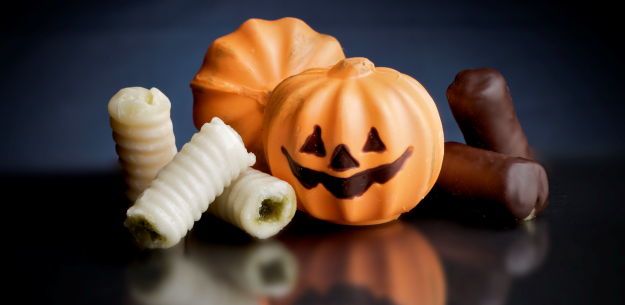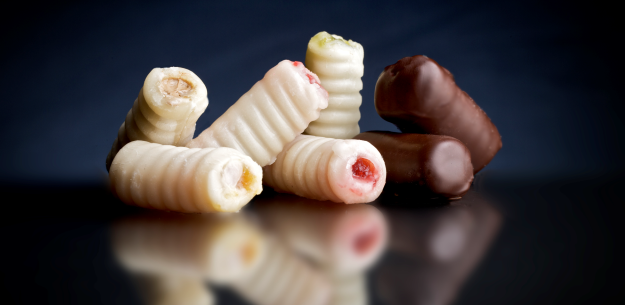.png.transform/rendition-xs/image_image%20(1).png)
Saintly Sweets
Halloween may be all about the candy for the youngsters who celebrate this holiday around the world, but in Spain, most people look forward to satisfying their sweet tooth just one day later on November 1st for El Día de Todos los Santos, or All Saint’s Day, the Spanish national holiday that has enough sugar to make Halloween blush and even a spookily named sweet (saint’s bones) for good measure.

For many people, Halloween – whose name derives from the 16th century phrase ‘All Hallows Eve’ - is the epitome of all things sweet. This holiday has come a long way from its roots many centuries ago and is now associated all over the world with costumes, haunted houses, cackling jack-o-lanterns, and candy, lots of candy. In Spain however, most people look forward to satisfying their sweet tooth just one day later on All Saint’s Day, a holiday that’s sometimes referred to as All Hallows. With a centuries-old tradition of typical sweets that are prepared on and around this day, El Día de Todos los Santos has enough sugar to make Halloween blush and even a spookily named sweet (saint’s bones) for good measure.
Given that All Saint’s Day has been celebrated throughout Spain for centuries, it’s no surprise that different regions have developed diverse gastronomic traditions for marking this occasion. In Extremadura, dulce de membrillo (sweet quince) is commonly eaten with toasted chestnuts, acorns or other nuts. Pestiños, which are typical in Andalusia, are made with flour, olive oil and sugar, and sometimes lemon, honey or sherry. They are then folded and fried like little bundles. Another sweet seasonal dish from Andalusia, and particularly Córdoba, is gachas de leche, which is made from flour, milk and either honey or sugar, and flavored with anise, cinnamon and lemon. The dumpling-like gachas are covered in milk and slightly resemble porridge. The most typical treats by far on this day, however, are huesos de santo, buñuelos and panellets. According to the Asociación Empresarial de Pastelería Artesana de la Comunidad de Madrid (Madrid Artisan Pastry Makers Business Association), sales predictions for these three artisanal sweets reach hundreds of thousands of kilograms in Madrid alone, with huesos de santo and buñuelos being the two most popular items. In fact, these two confections are perhaps the most universally consumed in Spain on this holiday, while panellets are more typical to Cataluña, a region where upwards of nine-hundred thousand kilograms of panellets might sell each year, according to the Cataluña Gremio de Pastelería (Bakers’ Guild).
Huesos de santo
Popular all over the country, these sweets are often associated with Madrid and Castile-León. Some accounts attribute their origin to 17th century Madrid, a theory that’s supported by their mention in Francisco Martínez Montiño’s cookbook, Arte de Cozina, Pastelería, Vizcochería y Conservería (The Art of Cooking, Pastries, Cakes and Preserves). Written in 1611, the book states that these sweets were “made to commemorate all the Saints and all the dead at the beginning of November”. Nevertheless, the origins of these marzipan-based huesos de santo can be traced even further back to the Moors, who left behind a legacy of confections made with almonds.
The appropriately – albeit somewhat gruesomely – named huesos de santo (saint’s bones), do in fact resemble reliquary bones. These slender, often whitish tubes are about 5-6cm in length and are ridged on the outside and hollow within. José Fernández-Ramos, the owner and pastry chef of the exquisite Nunos Pastelería in Madrid, makes the outer cylinder by blanching Spanish Marcona almonds in syrup. This results in fine marzipan dough that is then molded, filled and covered in a sugary glaze. The most traditional ’marrow’ is yema (sweetened egg yolk), although other popular variations include sweet squash, coconut, plum and chocolate. Fernández has taken this one step further with a range of flavors that includes sweet potato, orange, hazelnut praline, strawberry, dulce de leche and lemon. Additionally, he created a new variety this year filled with Belgian butter and another that’s dipped in the shop’s very own chocolate, which provides a pleasantly acidic and bitter contrast to the overtly sweet marzipan.
Notwithstanding the popularity of these confections, which are usually made during a week or two on either side of the November 1st holiday, Fernández attests that huesos de santo have a limited public, due to the fact that they are just so incredibly sweet. He sells around 500 kilograms a season of these typical pastries. Fortunately, Nunos Pastelería is a great place to taste a variety of All Saint’s Day sweets, not least of which are the chef’s specialty: buñuelos, of which he typically sells 4000-5000 kilograms.
Buñuelos
Buñuelos are essentially dough balls made with flour, butter (or lard) and eggs and deep fried in oil. Also called buñuelos de viento (meaning ‘puffed up’), the origins of these doughy sweets are often attributed to a tenth century Sephardic dish called bimuelos that was later adopted for the catholic saint’s day tradition. Other sources attribute these confections to the Moors who ate them fried in oil and then dipped in honey. Despite this long and varied history, the origin of buñuelos as we know them today is generally associated with old Madrid, where they were once served alongside churros in traditional shops and cafes. Today, buñuelos are a less sweet and more affordable alternative to huesos de santo, and are also easier for people to make at home. The dough balls are around the size of a ping-pong ball and are frequently filled with cream and other delights. At Nunos, I watched one of seven pastry chefs painstakingly filling each buñuelo by hand with ingredients like squash, crunchy almond and hazelnut praline, dulce de leche, Sicilian lemon and a range of different chocolates from Madagascar, Mexico and Ghana that were mixed with flavors like coffee and caramel. There is also a selection made with the shop’s own chocolate: Goson noir.
After filling me in (so to speak) on all these flavors, Fernández went on to explain that pastries are really about having fun. Therefore, the real flavor sensations come into play with the special collection of buñuelos that he creates every year. This year’s collection has a regional theme, featuring ten different kinds of buñuelos inspired by the gastronomic traditions of different areas of Spain: Andalusia (Pedro Ximénez cream with pestiños), Asturias (rice pudding with citrus aromas), Castilla (custard with cookies), Cataluña (crema Catalana with dulce de leche), Galicia (tarta de Santiago), Levante (horchata cream), La Rioja (Rioja crianza gel with cheese cream), Madrid (leche frita) and Basque Country (yoghurt cuajada with honey). These creative, delicious and visually evocative buñuelos are hugely popular, but will sadly only be available for around a month this year, leaving customers to wonder what next year’s collection might be. According to Fernández, Spain’s gastronomic traditions are so varied, plentiful and seasonal that you constantly have to move on and make room for the next.
Panellets
Before saying goodbye to the traditional Spanish sweets of All Saint’s Day, however, it’s essential to try the panellets. Today’s style of panellets originated in the 18th century, at which time it was customary to bring them to lengthy church services, wakes and funerals to share with friends and neighbors. Even so, their marzipan base (made with almonds, sugar, egg whites and lemon zest), also recalls the gastronomic influence of the Moors. These confections are particularly associated with Cataluña, but are also common in Valencia and the Balearic Islands. Panellets are usually round, although the marzipan makes them easy to shape into less traditional forms. They are rolled or covered in different coatings, with the most traditional being pine nuts. Other common varieties include almonds, coconut, chocolate (cocoa powder), coffee, hazelnut, chestnut, yema, quince, lemon and cherry. To mark All Saint’s Day, panellets are usually made starting on October 15, and in Cataluña are often accompanied by Cava or sweet moscatel wine. According to José Fernández, who makes a wide variety of panellets in Madrid, there are similar sweets made with pine nuts in Toledo and Andalusia that are called empiñonadas.
Whether pestiños, huesos de santo, buñuelos or panellets, the November 1st holiday is definitely the time to sharpen your sweet tooth on these traditional confections. Unfortunately, they’ll be gone before you know it!
For many people, Halloween – whose name derives from the 16th century phrase ‘All Hallows Eve’ - is the epitome of all things sweet. This holiday has come a long way from its roots many centuries ago and is now associated all over the world with costumes, haunted houses, cackling jack-o-lanterns, and candy, lots of candy
Adrienne Smith/©ICEX




- Image1
- Image2
- Image3
- Image4

